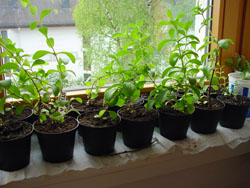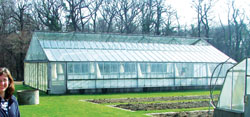Stevia rebaudiana is native to the tropic and subtropic areas of Paraguay and Brasil.
Here, in central European latitudes, the cultivation is Stevia is difficult as the perennial plant is not resistant to frost and would, if left outside, not weather out one winter.
Temperature plays a vital part in the cultivation of Stevia. The seeds nead a temperature of at least 22° degrees centigrade to germinate. Florida rooms or sunny spots close to a window are particularly favourable. Throughout the growth phase, the plant prefers a moist substrate.
We trialled several cultivation techniques using homegrown plants.

|
Cultivation Indoors:
It is particularly challenging to incite the germination of Stevia seeds. Only 2 out of a 1000 seeds that we planted finally germinated.
In comparison, it is much easier to use cuttings in order to reproduce Stevia.
We decided to seek support from the polytechnic school for horticulture in Schönbrunn. Ms Libowitzky agreed to rear and provide several plants for our project.
|
| A small plant which protects our teeth |
Stevia cuttings are about 3cm long, unlignified and from the upper and middle part of the plant. The cuttings were planted into a Neuhaus N3-substrate – an unfertilized rearing substrate suitable for the tender roots of the cuttings which are usually threatened to be “scorched“ by an excessive concentration of nitrogen. Then the cuttings were planted onto special rearing plates which detain less water than normal pots and prevent the plants from rotting. At an ambient temperature of 22°C and an atmospheric humidity of 95% - we used spray mist – the cuttings struck root. From the polytechnic school (HBLFA for horticulture) we received 32 cuttings together with basic information concerning the cultivation and care of Stevia.
When the plants arrived in Ursprung, two pupils volunteered to convert their dorms into a tropical greenhouse: we put up wet towels, turned up the heating and left the windows closed for most of the time.
We collected transparent plastic bags, punctured them and put them over the plantlets. Then we left them on the windowsill which just barely provided enough space for all the plants.
As we had nothing to put underneeth we decided to cover the windowsill with toilet paper to absorb all the draining water. This helped to keep the soil moist at all times.
Our efforts paid off well: the saplings thrived and prospered. On top of that, some even blossomed when only a few weeks old and still quite small!
In the face of such a success we bore the fact that our room was sticky and moist more easily. No need to take a vacation in the tropics!
As soon as the plants had grown stronger, we removed some of the plastic bags which didn’t seem to do any harm to their rate of growth – on the contrary!
Soon we had to support some of the plants in order to prevent them from falling over and snapping off. |
|
Now Stevia has shown its potential afield…
|
Some other plants, however, just refused to grow and while the largest plants had reached 30cm, the smallest plants were still below 1cm.
We still have not found any explanation for this phenomenon. All plants were reared under the same conditions.
The larger plants can be planted outside by June. A larger space helps the plant to spread out. Stevia needs to be moved into a pot again as soon as the first frosts threaten to arrive. Then it should be hibernated in a dark and cool room. Even though the winter is a rest period, the roots must not dry out at any point. The plant should start to sprout as soon as days increase in length. If the climatic conditions are more advantageous one can skip a rest period. However, this procedure renders the plant more susceptible to diseases and pest.

|
Cultivation in the Field
In the later months of spring, we were able to start our experiment afield. We picked out a suitable plot on our campus and went straight to work.
We borrowed a tractor and a plow from the school farm to plow up our field. As the plowed soil is too rough for Stevia, we needed to come up with a quick and easy solution…
|
Summer, sun
and an atmosphere almost like home….
|
The gardeners among our teachers were quite amazed when they found their darling garden tiller to have disappeared and to have been converted into some kind of blender! We used the tiller to scuff the ploughed soil and, simultaneously, to work organic matter like bark and straw into the soil. Even though Stevia is sensitive to fertilization, it does not mind organic matter.
After that we had to laboriously clear the plot of weeds as Stevia needs to be raised on its own.
It is important to keep the gap between the plants quite small because then they can support each other. After we had planted all the specimen/ saplings, we covered the soil in between with bark to prevent other weeds from growing.
We are curious about how the plants will develop and whether we will be able to harvest some leaves.
Cultivation of Stevia in Austria
As pupils from an agricultural school, we discussed possible issues of the cultivation of Stevia in Europe to a great extent. During our research we found out that the plant could be cultivated as an alternative to tobacco. In Austria, the climatic conditions of Lower Carinthia and Burgenland are ideal. Especially for organic farmers Stevia might present a promising market niche. As the EU is doing trials to cultivate Stevia in Portugal, one can expect the production to be authorized in the near future. |
|
… what other secrets are hid away in this plant?
|
|
